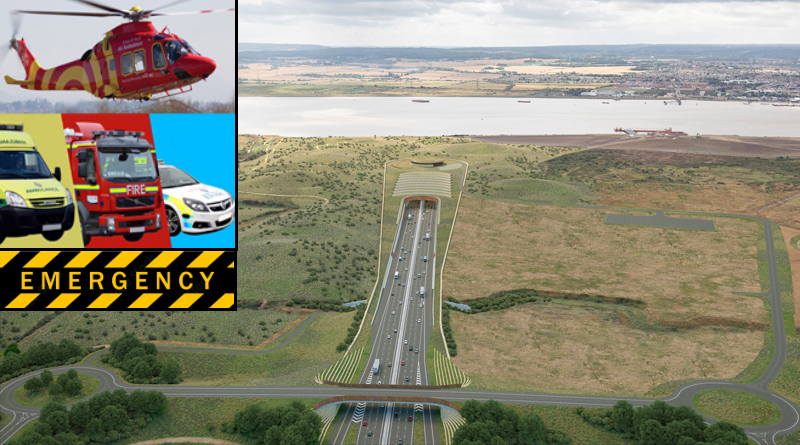Impacts to Emergency Services
We’ve been voicing serious concerns about the impacts to emergency services for years now. As the LTC DCO examination has started it is becoming more apparent that others, including the emergency services themselves have concerns about the proposed LTC.
Emergency services and host local authorities have formed the Emergency Services & Safety Partners Steering Group (ESSP SG) specifically for dealing with LTC issues and concerns.
The ESSP SG is made up of Kent Police, Kent Fire and Rescue Service, Essex Police, East of England Ambulance Service NHS Trust, Essex County Fire and Rescue Service, Southeast Coast Ambulance Service NHS Foundation Trust, Metropolitan Police, Thurrock Council, Gravesham Council, Kent County Council, Essex County Council.
The steering group considers that it has an important role in ensuring that the LTC, if granted DCO, will be a safe and secure transport development which does not have an adverse impact or place unacceptable burdens on the ability of its members to deliver their important services.
In September 2021 the ESSP SG provided 56 Recommendations to the Applicant on how the project could be developed. However, progress as a result of engagements between the steering group and National Highways/LTC has been slow, and there are still a number of areas of Key Concern that the ESSP SG are raising in representations to the Examiners. You can search the Examination Library to read their representations.
So what are TCAG’s concerns about impacts to Emergency Services?
Even before the LTC opens, if it goes ahead, there would of course be at least 6-7 years of construction. Such a large construction project of course comes with risks to health and safety, and therefore increases the likelihood of impacts to our emergency and healthcare services, that are already stretched to say the least.
During construction there would also be many road closures and diversions in place, which would of course again impact access and response times for emergency services within our communities.
Similarly, once opened (if it goes ahead) it is clear that there would be high numbers of incidents both on the LTC as well as there remaining a high level of incidents at the current Dartford Crossing.
Not only do these incidents often result in the need for emergency services to attend, they also create congestion throughout the region. The result is that not only does it cause issues for the emergency services attending the incidents, but also to their response times attending other call outs in our communities.
The proposed LTC would be a ‘smart’ motorway by stealth which bring their own risks and dangers, that in turn increase pressures on our emergency services. Not to mention the fact that no hard shoulder makes it harder for emergency services to reach incidents.
Electric Vehicle fires are extremely difficult to extinguish and release a number of nasty toxic gases. This can be dangerous in normal circumstances, but imagine it in a tunnel like the proposed LTC tunnels. Remember NH/LTC have said that traffic in the tunnels will push the air/pollution through and out of the tunnels, and if traffic slows down fans will automatically come on, which would fan the flames of a fire. EV fires can take longer to put out, and can also reignite (sometimes days after being put out). It takes a lot more water to put out an EV fire, and the then contaminated water pollutes water and soil. Some fire services, including Essex, Kent, and London are now sending two fire engines to EV fires, further impacting stretched emergency services.
There are also questions to be asked about how accessible the proposed LTC would be for emergency services to attend incidents on the road, if it goes ahead, and whether provisions are in place and adequate.
There is an Operations and Emergency Access Point off the LTC near Tilbury/East Tilbury, near the northern tunnel portals. As well as emergency vehicle access roads to the LTC at a few locations along the proposed route, all of which of course involve emergency vehicles needing to use local roads and lanes to reach them. Additionally the A1089 requires an additional emergency vehicle access road, since the proposed LTC would sever the A13 to A1089 direct access, which results in traffic access issues in its own right.
Not only that but it has been highlighted that the Operations and Emergency Access Point would be used to turn traffic around when there are incidents, which could further reduce accessibility for emergency services, and is very close to the tunnel portals. As well as the fact that this ‘junction’ also offers provision for the development of a future junction, ie the Tilbury Link Road.
On top of all this remember that there are forecast to be 2,147 additional accidents over 60 years, including 26 fatalities, 220 serious injuries and 3,122 slight injuries, if the proposed LTC goes ahead.
We’d definitely be seeing an increase in demand for our already stretched emergency services, impacting them and our hospitals, road users, and our communities. Whenever we’ve raised concerns with NH/LTC about our concerns on this aspect over the years they have suggested they are in discussions with the emergency services as if everything is in hand, when clearly it is becoming more and more apparent this is not the case. Our serious concerns remain.
Related
LTC – road safety – click here
LTC – incidents – click here
LTC ‘Smart’ Motorway by stealth – click here
Operations and emergency access point – click here

